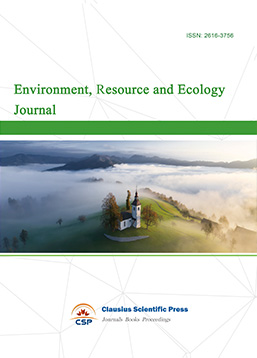Petrophysical Analysis and Distribution Prediction of Asphaltene Reservoir of Longwangmiao Formation in Longnusi Area, Central Sichuan
DOI: 10.23977/geors.2024.070108 | Downloads: 14 | Views: 1167
Author(s)
Liang Hong 1, Wu Furong 1, Zhao Xiaohui 1, He Chuanhang 1, He Chengxiaotao 1
Affiliation(s)
1 BGP, CNPC, Zhouzhou, Hebei, 072050, China
Corresponding Author
He ChuanhangABSTRACT
Taking the asphaltene carbonate reservoir of Longwangmiao formation in the longnusi area of the Sichuan Basin as an example, the petrophysical analysis and seismic prediction methods of the asphaltene reservoir are discussed. Asphaltene in the actual formation mainly exists in the reservoir in liquid form, with complex spatial distribution, which makes it easy to block the pore throat channel and reduce the practical space of the reservoir, resulting in poor reservoir connectivity. The asphaltene petrophysical characteristics are quite different from the surrounding rock. Still, the content is only about 1 ~ 4%, which leads to the weak influence of asphaltene on the petrophysical characteristics of the reservoir and the difficulty of asphaltene reservoir prediction. In this paper, a set of integrated research ideas and methods based on core and logging data interpretation, petrophysical analysis, and prestack inversion prediction are formed: the logging response characteristics of the asphaltene reservoir are analysed based on the comparison of the core and logging curve, the logging evaluation process of asphaltene reservoir is formed, and the relative asphalt content is calculated by using conventional porosity curve and nuclear magnetic porosity; The petrophysical analysis of reservoir section is carried out, and it is considered that VP / vs. can effectively partition asphaltene reservoir; Finally, pre-stack inversion technology is used to predict asphaltene reservoir. The actual drilling proves that the prediction results of the asphaltene reservoir by this method are in good agreement, indicating that there is a set of asphaltene carbonate reservoirs with asphalt content of more than 2% and an average thickness of 20m in the study area, which realises the quantitative evaluation of asphaltene carbonate gas reservoir and has reference value for the prediction of such asphaltene reservoir.
KEYWORDS
Asphaltene Reservoir; Rock physics experiment; Effective porosity calculation; Asphalt content calculation; Prestack inversion; Cambrian Longwangmiao formationCITE THIS PAPER
Liang Hong, Wu Furong, Zhao Xiaohui, He Chuanhang, He Chengxiaotao, Petrophysical Analysis and Distribution Prediction of Asphaltene Reservoir of Longwangmiao Formation in Longnusi Area, Central Sichuan. Geoscience and Remote Sensing (2024) Vol. 7: 64-74. DOI: http://dx.doi.org/10.23977/geors.2024.070108.
REFERENCES
[1] Ji., Y., et al. Influence of solid asphalt on reservoir performance [J]. Petroleum Exploration and Development. 1995, 22(4): 87-90.
[2] Zhou., J., et al. Genesis and evolution of Lower Cambrian Longwangmiao Formation reservoirs, Sichuan Basin, SW China [J]. Petroleum Exploration and Development. 2015, 42(2): 158-166.
[3] Hu., S., et al. Asphalt-Sealed Belt In Reservoirs And Its Implication To Petroleum Exploration [J]. Natural Gas Geoscience. 2007, 18(1): 99-103.
[4] Zhang., C., et al. Studies on Rock-electrical Parameters in Asphaltic Sand Reservoirs [J]. Journal of Oil and Gas Technology. 2009, 31(6): 90-94.
[5] Lai., Q., et al. Petrophysical characteristics and logging evaluation of asphaltene carbonate reservoirs: A case study of the Cambrian Longwangmiao Formation in Anyue gas field, Sichuan Basin [J]. Petroleum Exploration and Development. 2017, 44(6): 889-895.
[6] Chen., G., et al. Establishment of fluid identification factor by joint acoustic and resistivity logging and its application: a case study of carbonate gas reservoir in the Northeast Sichuan [J]. Geophysical Prospecting for Petroleum. 2017, 56(02):295-301.
[7] Gu., Z., et al. Accumulation conditions and exploration directions of natural gas in deep subsalt Sinian-Cambrian System in the eastern Sichuan Basin, SW China [J]. Petroleum Exploration and Development. 2015, 42(2): 137-149.
[8] Sima., L. and Shu., Z., Logging evaluation method and application of carbonate reservoir [M]. Beijing, Petroleum industry press, 2008.
[9] Zhang., S. et al. Improved time domain analysis method for NMR logging in complex oil-water reservoirs [J]. Geophysical Prospecting for Petroleum. 2021, 60(04):686-692.
[10] Zhang., H., et al. Nuclear magnetic resonance relaxation mechanism and fluid identification in oil wet tight sandstone reservoirs [J]. Geophysical Prospecting for Petroleum. 2020, 59(03):422-429+440.
[11] Yang., F., et al. Carbonate reservoir prediction with broadband seismic data: A case study from the East Block B of Pre-Caspian Basin [J]. Geophysical Prospecting for Petroleum. 2019, 58(04):555-562.
[12] Shi., L., et al. Physical properties prediction for tight sandstone reservoirs [J]. Geophysical Prospecting for Petroleum. 2020, 59(01):98-107.
[13] Yin., X., X., Liu., and S., O., Geosciences. Research status and progress of the seismic rock-physics modeling methods [J]. Geophysical Prospecting for Petroleum. 2016, 55(03):309-325.
[14] Wen., Z., et al. Application of quantitative crossplot technique in fluid identification [J]. Geophysical Prospecting for Petroleum. 2008, 47(1):45-48.
[15] Yuan., S., et al. Progress of pre-stack inversion and application in the exploration of the lithological reservoirs [J]. Progress in Geophysics. 2007, 22(3):879-886.
[16] Gao., J., et al. Seismic phase-controlled nonlinear inversion of a carbonate reservoir [J]. Geophysical Prospecting for Petroleum. 2020, 59(03):396-403.
| Downloads: | 1086 |
|---|---|
| Visits: | 114291 |
Sponsors, Associates, and Links
-
International Journal of Geological Resources and Geological Engineering

-
Big Geospatial Data and Data Science

-
Solid Earth and Space Physics

-
Environment and Climate Protection

-
Journal of Cartography and Geographic Information Systems

-
Environment, Resource and Ecology Journal

-
Offshore and Polar Engineering

-
Physical and Human Geography

-
Journal of Atmospheric Physics and Atmospheric Environment

-
Trends in Meteorology

-
Journal of Coastal Engineering Research

-
Focus on Plant Protection

-
Toxicology and Health of Environment

-
Advances in Physical Oceanography

-
Biology, Chemistry, and Geology in Marine

-
Water-Soil, Biological Environment and Energy

-
Geodesy and Geophysics

-
Journal of Structural and Quaternary Geology

-
Journal of Sedimentary Geology

-
International Journal of Polar Social Research and Review


 Download as PDF
Download as PDF